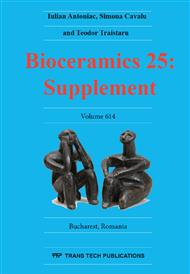[1]
L. Pröbster, El desarrollo de las restauraciones completamente cerámicas. Un compendio histórico (I), Quintessence (ed. esp). 11(1998) 515-9.
Google Scholar
[2]
BE. Pjetursson , NP Lang, Prosthetic treatment planning on the basis of scientific evidence, J Oral Rehabil. 35(2008)72-9.
DOI: 10.1111/j.1365-2842.2007.01824.x
Google Scholar
[3]
BE. Pjetursson , U. Brägger, NP. , M. Zwahlen, Comparison of survival and complication rates of tooth-supported fixed dental prostheses (FDPs) and implant-supported FDPs and single crowns (SCs), Clin Oral Implants. 18 (2007) 97-113.
DOI: 10.1111/j.1600-0501.2007.01439.x
Google Scholar
[4]
JD. Anderson, Ten-year survival rate for cantilevered fixed partial dentures, Evid Based Dent. 6(2005) 96-7.
DOI: 10.1038/sj.ebd.6400365
Google Scholar
[5]
G. Ioannidis, T. Paschalidis, HP. Petridis , V. Anastassiadou, The influence of age on tooth supported fixed prosthetic restoration longevity. A systematic review. J Dent. 38(2010)173-81.
DOI: 10.1016/j.jdent.2009.12.002
Google Scholar
[6]
A. Jokstad, After 10 years seven out of ten fixed dental prostheses (FDP) remain intact and nine out of ten FDPs remain in function following biological and technical complications that have been repaired, J Evid Based Dent Pract. 10(2010) 39-40.
DOI: 10.1016/j.jebdp.2009.11.019
Google Scholar
[7]
MS. Scurria, JD. Bader, DA. Shugars, Meta-analysis of fixed partial denture survival: prostheses and abutments, J Prosthet Dent. 79(1998) 459-64.
DOI: 10.1016/s0022-3913(98)70162-3
Google Scholar
[8]
NH. Creugers, AF. Käyser, MA. Van 't Hof, A meta-analysis of durability data on conventional fixed bridges, Community Dent Oral Epidemiol. 22(1994)448-52.
DOI: 10.1111/j.1600-0528.1994.tb00795.x
Google Scholar
[9]
DR. Haselton, AM. Diaz-Arnold, SL Hillis SL, Clinical assessment of high-strength all-ceramic crowns, J Prosthet Dent 83 (2000)396-401.
DOI: 10.1016/s0022-3913(00)70033-3
Google Scholar
[10]
M. Fradeani, A. Aquilano, M. Corrado , Clinical experience with In-Ceram Spinell crowns: 5-year follow-up, Int J Periodontics Restorative Dent 22(2002) 525-33.
Google Scholar
[11]
M. Fradeani, M. D'Amelio, M. Redemagni, M. Corrado, Five-year follow-up with Procera all-ceramic crowns, Quintessence Int 36 (2005) 105-13.
Google Scholar
[12]
P. Marquardt , JR. Strub,. Survival rates of IPS empress 2 all-ceramic crowns and fixed partial dentures: results of a 5-year prospective clinical study, Quintessence Int37 (2006)253-9.
Google Scholar
[13]
TR. Walton , A 10-year longitudinal study of fixed prosthodontics: clinical characteristics and outcome of single-unit metal-ceramic crowns, Int J Prosthodont 12(1999) 519-26.
Google Scholar
[14]
AJ. Raigrodski, GJ. Chiche, N. Potike et al. The efficacy of posterior three-unit zirconiumoxide-based ceramic fixed partial dental prostheses: a prospective clinical pilot study, J Prosthet Dent 96 (2006)237-44.
DOI: 10.1016/j.prosdent.2006.08.010
Google Scholar
[15]
MJ. Suarez, JF. Lozano, M. Paz Salido,F. Martinez , Three-year clinical evaluation of In-Ceram Zirconia posterior FPDs, Int J Prosthodont 17(2004) 35-8.
Google Scholar
[16]
KG. Olsson, B. Furst, B. Andersson, GE. Carlsson, A long-term retrospective and clinical followup study of In-Ceram Alumina FPDs, Int J Prosthodont 16 (2003) 150-6.
Google Scholar
[17]
A. Eliasson, CF. Arnelund, A. Johansson, A clinical evaluation of cobalt-chromium metal-ceramic fixed partial dentures and crowns: A three- to seven-year retrospective study, J Prosthet Dent. 98(2007)6-16.
DOI: 10.1016/s0022-3913(07)60032-8
Google Scholar
[18]
PJ. Leempoel, AF. Käyser, GM. Van Rossum, AF. De Haan, The survival rate of bridges. A study of 1674 bridges in 40 Dutch general practices,. J Oral Rehabil. 22(1995)327-30.
DOI: 10.1111/j.1365-2842.1995.tb00780.x
Google Scholar
[19]
S. Karlsson,. Failures and length of service in fixed prosthodontics after long-term function. A longitudinal clinical study, Swed Dent J. 13(1989)185-92.
Google Scholar
[20]
CH. Hämmerle, MC. Ungerer, PC. Fantoni, U. Brägger, W. Bürgin, NP. Lang, Long-term analysis of biologic and technical aspects of fixed partial dentures with cantilevers, Int J Prosthodont. 13(2000)409-15.
Google Scholar
[21]
V. Decock, K. De Nayer, JA. De Boever, 18-year longitudinal study of cantilevered fixed restorations,. Int J Prosthodont. 9(1996)331-40.
Google Scholar
[22]
E. Lindquist, S. Karlsson, Success rate and failures for fixed partial dentures after 20 years of service: Part I, Int J Prosthodont. 11(1998)133-8.
Google Scholar
[23]
HT. Shillimburg, Basis of fixed Prosthodontics, Quintessence, Barcelona, (1978).
Google Scholar


